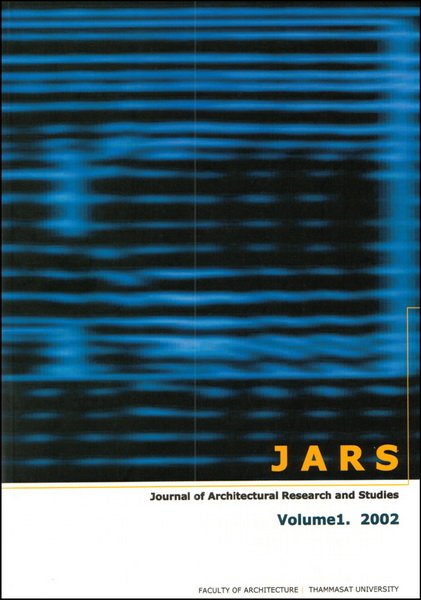CFD Approach towards Natural Ventilation Design: Guidelines for Houses in Thailand
Main Article Content
Abstract
This paper explores the potential of using natural ventilation as a passive cooling system for house designs in Thailand by using computational fluid dynamics (CFD). The characteristics of past and present Thai houses are analyzed in terms of climate, culture, and technology. Based on the thermal comfort requirements for the Thai people and the climate conditions in Bangkok, the study has found that it is possible to use natural ventilation to create a thermally comfortable indoor environment in houses in a Bangkok suburb during 20% of the year. The analysis of site planning reveals that houses with compact shape have a better ventilation rate than those with elongated shape. To maximize the ventilation rate, the study of a prototype house finds that the size of the openings has to exceed 40% of the area of the house. This research also develops comprehensive design guidelines for natural ventilation at both the site planning and individual house levels.
Downloads
Article Details

This work is licensed under a Creative Commons Attribution-NonCommercial-NoDerivatives 4.0 International License.
All material is licensed under the terms of the Creative Commons Attribution 4.0 International (CC-BY-NC-ND 4.0) License, unless otherwise stated. As such, authors are free to share, copy, and redistribute the material in any medium or format. The authors must give appropriate credit, provide a link to the license, and indicate if changes were made. The authors may do so in any reasonable manner, but not in any way that suggests the licensor endorses you or your use. The authors may not use the material for commercial purposes. If the authors remix, transform, or build upon the material, they may not distribute the modified material, unless permission is obtained from JARS. Final, accepted versions of the paper may be posted on third party repositories, provided appropriate acknowledgement to the original source is clearly noted.
References
The American Society of Heating Refrigerating and Air-conditioning Engineers. (1995). ASHRAE Standard 55a-1995: Thermal environmental conditions for human occupancy. Atlanta: ASHRAE.
Lovins, A. B. (1992). Air conditioning comfort: Behavioral and cultural issues. Boulder, Colorado: E Source, Inc.
Busch, J. F. (1992). A tale of two populations: Thermal comfort in air-conditioned and naturally ventilated offices in Thailand. Energy and Buildings, 18, 235-249.
Cowan, H. J. (1991). Handbook of architectural technology. New York: Van Nostrand Reinhold.
Olgyay, V. (1963). Design with climate: A bioclimatic approach to architectural regionalism. Princeton: Princeton University Press.
Kwok, A. G. (1998). Thermal comfort in tropical classrooms. ASHRAE Transactions, 104(1).
Jitkhajornwanich, K., Pitts, A. C., Malama, A., & Sharples, S. (1995). Thermal comfort in transitional spaces in the cool season of Bangkok. ASHRAE Transactions, 1181-1193.
Lechner, N. (1991). Heating, cooling, lighting: Design method for architects. New York: John Wiley & Sons.
Ashley, K. S. (1984). Natural ventilation cooling of buildings. Port Hueneme, California: Naval Civil Engineering Laboratory.
Khedari, J., Yamtraipat, N., Pratintong, N., & Hirunlabh, J. (2000). Thailand ventilation comfort chart. Energy and Buildings, 32, 245-249.
Thai Gypsum Products Public Company Limited. (1995). Energy efficient design of buildings in Thailand.Bangkok: Thai Gypsum Products Inc.
Moore, F. (1993). Environmental control system: Heating cooling lighting. Singapore: McGraw-Hill Inc.,
CHAM. (1998). PHOENICS Version 3.1. London: CHAM Ltd.
Zhai, Z., Hamilton, S. D., Huang, J., Allocca, C., Kobayashi, N., & Chen, Q. (2000). Integration of indoor and outdoor airflow study for natural ventilation design using CFD. Proceedings of the 21st AIVC Annual Conference on Innovations in Ventilation Technology. The Hague, The Netherlands.
Givoni, B. (1994). Passive and low energy cooling of buildings. New York: John Wiley & Sons, Inc.
Evans, B. (1989, March). Letting fresh air back into buildings: The evolving state of the art of natural ventilation. Architecture, 72-77.
Hirunlabh, J., Kongduang, W., Namprakai, P., & Khedari, J. (1999). Study of natural ventilation of houses by a metallic solar wall under tropical climate. Renewable Energy, 18, 109-119.
Hirunlabh, J., Wachirapuwadon, S., Pratinthong, N., & Khedari, J. (2001). New configurations of a roof solar collector maximizing natural ventilation. Building and Environment, 36, 383-391.
Khedari, J., Boonsri, B., & Hirunlabh, J. (2000). Ventilation impact of a solar chimney on indoor temperature fluctuation and air change in a school building. Energy and Buildings, 32, 89-93.
Khedari, J., Waewsak, J., Thepa, S., & Hirunlabh, J. (2000). Field investigation of night radiation cooling under tropical climate. Renewable Energy, 20, 183-193.


